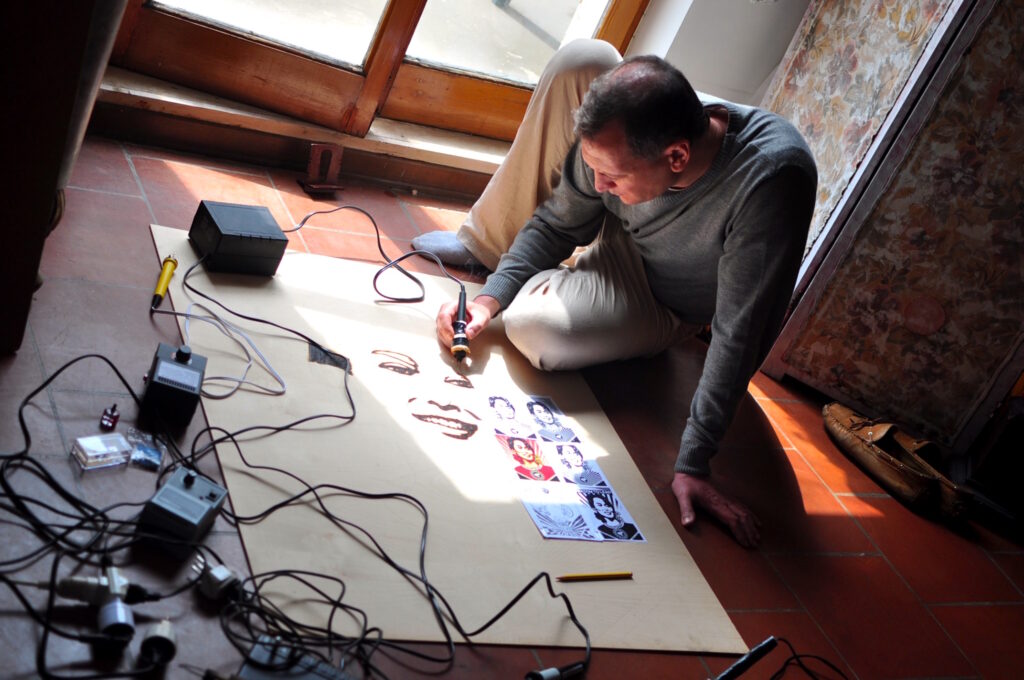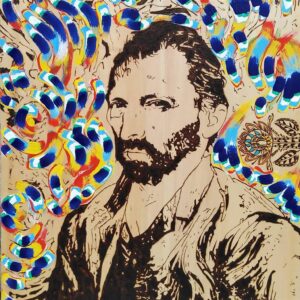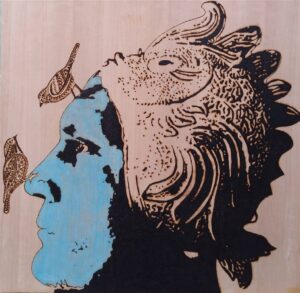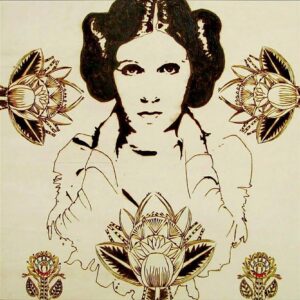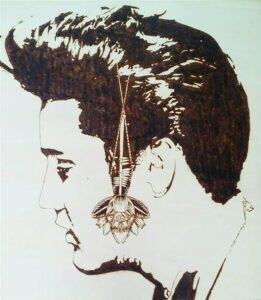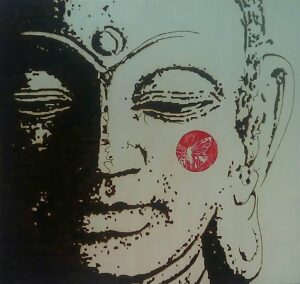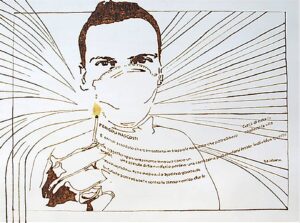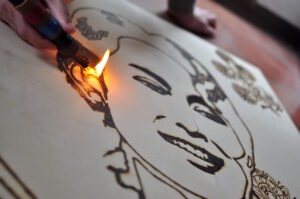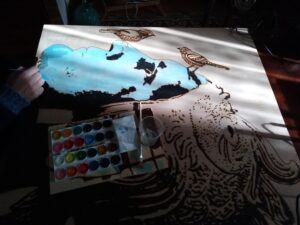Italian artist Carlo Proietto creates graphic imagery through the age-old technique of pyrography.
Using a heated metallic point, the artist wields fire into clean lines and crisp forms to compose contemporary designs. His monochromatic creations, which are at times offset by solitary splashes of color, convey deep passions and forms of expressionism within figurative and surrealistic styles.
Working mostly in a square format, the artist renders boxlike montages which mimics the layout of a modern graphic novel. Within these vignettes, we see glimpses of universal themes like humans struggling with the mechanisms of the outer world, such as the new forced restrictions implemented by COVID-19.
Proietto also looks to contemporary culture and Pop Art to create an entirely new mythology reflective of the human experience within the highly urbanized, industrial context we have all come to know. Icons from contemporary culture such as Princess Leia, Elvis and Basquiat, are reassigned layers of meaning through the transformational power of fire, lending a sense of drama to their overall effect.
A forerunner in elevating the technique of pyrography, Proietto has published a book on pyrography as a contemporary art form.
Proietto’ new solo exhibition Reverie of Fire will premiere a series of the artist’s signature pyrographic prints, whose creations are defined by a careful use of line and form within judiciously composed surreal scenes. The exhibition will be on view at Agora Gallery from September 1 through September 22, with a public opening reception on September 10 from 6-8pm.
How did you first arrive at pyrography? Did you seek it out or did it find you?
When I was 11 years old, I discovered a soldering iron at home in a drawer, as if in a dream. Captivated by the movement of the flame, the instrument seemingly came to life right before my eyes. I heard the sizzling noises of the burnish incising a substrate and I smelled the unmistakable odor of material surfaces burning. It was sensational and magnificent! Later on, during my studies at the Academy of Fine Arts, I received a pyrography instrument as a gift, and everything fell into place very quickly. I studied up on the technique and I became hooked on this intriguing medium.
How important is scale and proportion when creating a piece?
For me, everything is important when I make a pyrographic work: the size, the proportions and the message. I approach the process with discipline and hard work. I always try to convey what I am and not what I feel. This is often very difficult as art is a serious matter.
Much of your work is informed by a graphic novel format as well as video games and contemporary music. Can you explain the origins of these influences in a historical art form?
Video games and contemporary music have made a strong impact on me. I am always up to date with music videos and video games of the moment and I believe that by both observing and participating in contemporary culture a person can better understand themselves.
Fire is a potent element that you credit as “a transformational power” in your art making process. Please elaborate on this statement.
I was seeking new inspiration in art making so I decided to embrace a technique that was unexplored in a contemporary format. With pyrography, I am able to capture the viewer’s attention by painting with fire. My practice is fueled by the notions of rebirth and the transformational power of fire. I find that the public is always happy to see my works and I hope that they can share the idea that I invented something new.
Can you discuss the layers of symbology and meaning that are assigned to your work through the use of pyrography?
The symbology featured in my compositions is dictated by the past. When I made my first pyrographic series–a group of 12 mandalas–I found that I was able to make them quickly and intuitively. It was as if each image was being channeled through the metal burnish like a magic wand. I feel fortunate by having studied only topics in which I am interested. I consider this aspect to be very important because my artistic self and practice has not been affected or conditioned by art school. Consequently, the decorative and symbolic motifs in my art are the most pleasant and natural aspect for me. I view them to be messages from the past, of sorts.
Thematically, your work references pop culture icons like Princess Leia, Elvis, Basquiat and Buddha. What is the importance of these subjects in relation to your art?
The references of these characters are dictated by the curiosity and charm that I feel by observing them and knowing their story. I like to personalize them in pyrography, because I feel like it adds to their magic and mystique.
Who are some artistic influences for your work and practice?
I am inspired by MC Escher and woodcut etchings. Before I became a pyrographer, I was an engraver for many years. Working in a black and white palette with a strong economy of line undoubtedly has shaped my practice.
How much does personal travel lend itself to your creative process?
I am very lucky to be able to travel frequently and it has become an important element in developing my practice. I am always present at my exhibitions in order to grow as an artist and observe others interacting with my work. In many ways, I feel that I am a citizen of the world, not just an Italian. I like studying other cultures and learning about their rituals and traditions. When I return from a trip, I am saturated with new thoughts and ideas which I liken to the concept of having read many books at once.
Speaking of books, you wrote a book about this art form.
Thank you, I am very happy with my book Pyrography. It is almost three hundred pages and comes with a demonstration DVD. This book has also been translated into English. It is now sold all over Italy and online. In researching my book, I bought every book on pyrography that I could find from 1929 to today. I am sure that my volume contains the most extensive information on the technique, in addition to presenting the art of pyrography in a contemporary format.
How has your work and creative approach changed since the onset of COVID?
I can’t tell you what has changed. During this dark period, I have left the studio and dedicated myself to reading.

